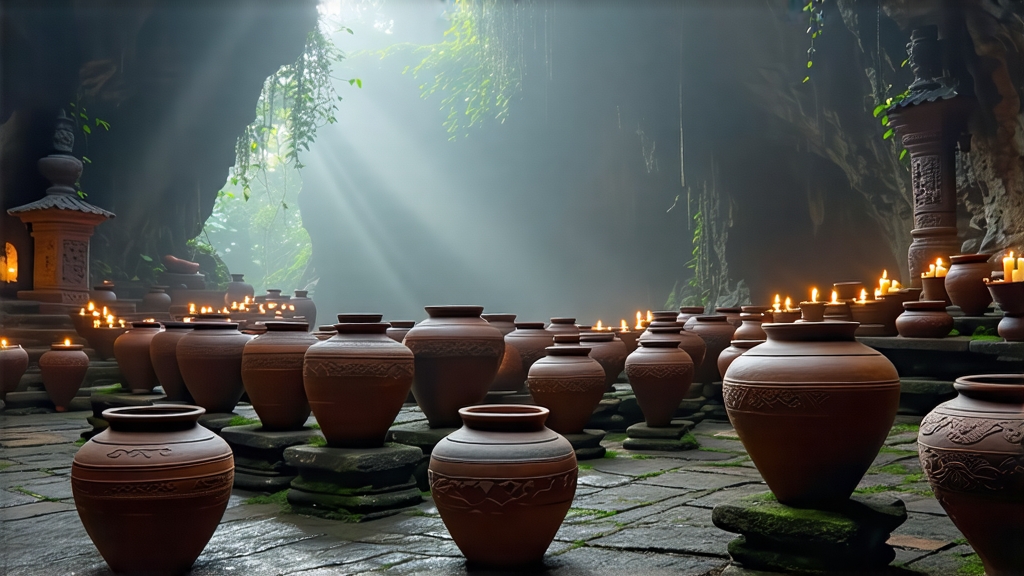
Tucked into the creases of the subtropical Dayao Mountains in Guangxi Province, Liupu tea (often written Liu Bao) is the quietest celebrity of China’s dark-tea family. While Pu-erh hoards the limelight, Liupu has spent four centuries maturing in clay jars, bamboo baskets and limestone caves, emerging with a crimson liquor that smells like rain on old camphor and finishes with the sweetness of dried longan. For the international drinker who thinks “black tea” means Indian breakfast tea, Liupu is a passport to an entirely different hemisphere of flavor—one where fermentation is not a flaw but a dialogue between microbe, leaf and time.
Historical footprints
The first written record appears in 1662, when the Qing court taxed “Guangxi border tea” en route to the Pearl River Delta. Jute-bound baskets of Liupu were lashed to the bamboo masts of river boats, travelling the Xunjiang and Pearl rivers to Guangzhou’s Thirteen Factories, then on to Hong Kong and Malaya. Miners in 19th-century Ipoh swore the tea dissolved the grease of tin-ore dust; coolies in Singapore’s docks traded half-day wages for a brick they could shave into kettles. Because the voyage was humid and long, the tea arrived already half-fermented; merchants discovered the deeper the color, the higher the price. Thus a logistical accident became a house style, and Liupu’s identity was sealed as the tea that must travel to become itself.
Terroir and leaf
Guangxi’s karst topography breathes. Daily mountain mist blocks scorching sun, while nightly fog carries the scent of wild camphor laurels into tea gardens. The indigenous large-leaf variety, Camellia sinensis var. sinensis f. macrophylla, has cells twice the diameter of those in Fujian’s bushes, storing more polyphenols and caffeine for the long microbial journey ahead. Farmers pick yi ya san ye—“one bud, three leaves”—after Guyu (Grain Rain) when the monsoon begins, ensuring the leaf is thick enough to withstand the soon-to-come 85 % relative humidity.
From basket to cave: craft in six movements
- Sha Qing (Kill-Green) – 280 °C wok, three minutes, no more. Enzymes must be stilled yet leaf walls kept intact for later microbial piercing.
- Rolling – A barefoot tread on bamboo crates, curling cells into spirals without breaking veins, a technique borrowed from nearby Yao minority rice-wine makers.
- Sun-drying – Spread on hemp cloth atop limestone boulders that radiate heat even after sunset, reducing moisture to 13 % while impregnating the leaf with minerals that act as yeast nutrients.
- Pile-Fermentation (Wo Dui) – The signature step. Leaves are moistened with mountain spring water, stacked 70 cm high under jute covers, and turned every five days. Indigenous Aspergillus niger, Blastobotrys adeninivorans and a local yeast Kodamaea ohmeri raise the pile temperature to 55 °C, oxidizing catechins into theaflavins and releasing a camphor-laced aroma that villagers can smell from the valley road. After 25–30 days the leaf has turned walnut-brown; a golden “golden flower” (Eurotium cristatum) sometimes freckles the surface, the same desirable mold coveted in Fu brick tea.
- Basket Pressing – The warm tea is rammed into 30 kg cylindrical jute baskets lined with wild banana leaf. As the cargo cools, the bamboo hoop contracts, squeezing air out and creating an anaerobic core where slow, secondary fermentation will continue for decades.
- Cave Aging – Traditionally baskets were stored in limestone caves whose constant 20 °C and 85 % humidity allow micro-aerobic fermentation year-round. Modern producers replicate the cave climate in tiled basements, but the most sought-after lots still rest in the cool breath of karst chambers for a minimum of seven years, emerging with a dusty white bloom that collectors call “cave plum bloom.”
Grades and tasting map
Liupu is sold by both age and leaf grade. The top tier, “Special Grade,” uses pre-Qingming buds and is cave-aged 15–30 years, yielding a liqueur the color of Château d’Yquem. “First Grade” blends